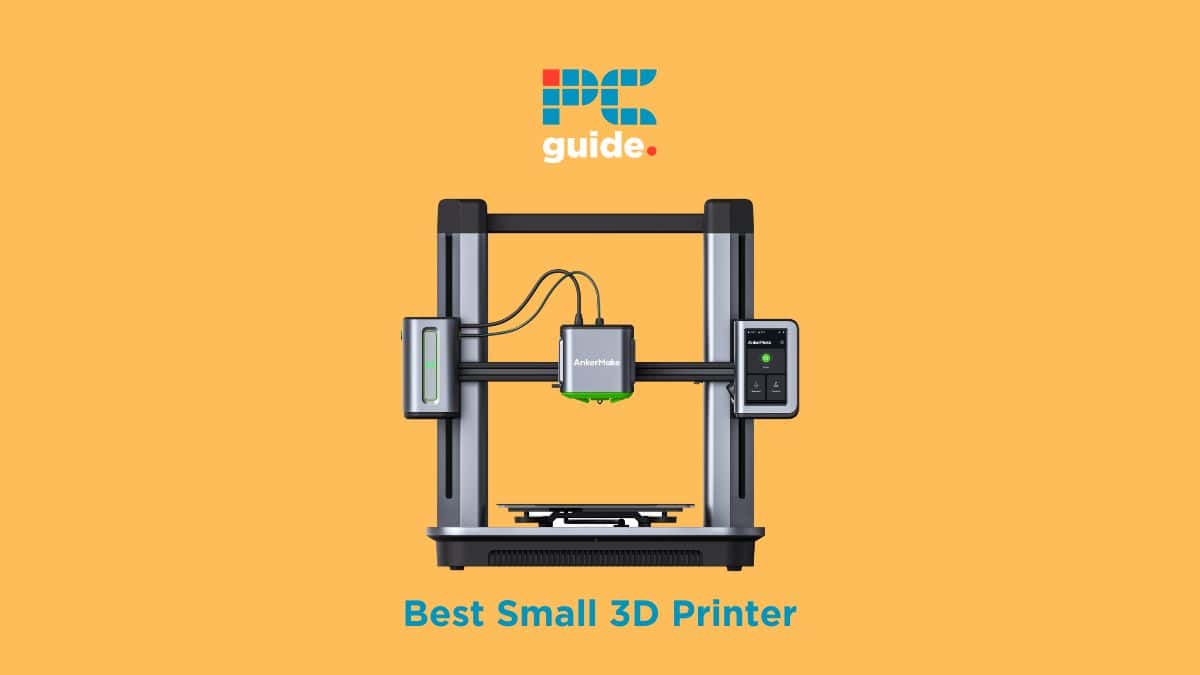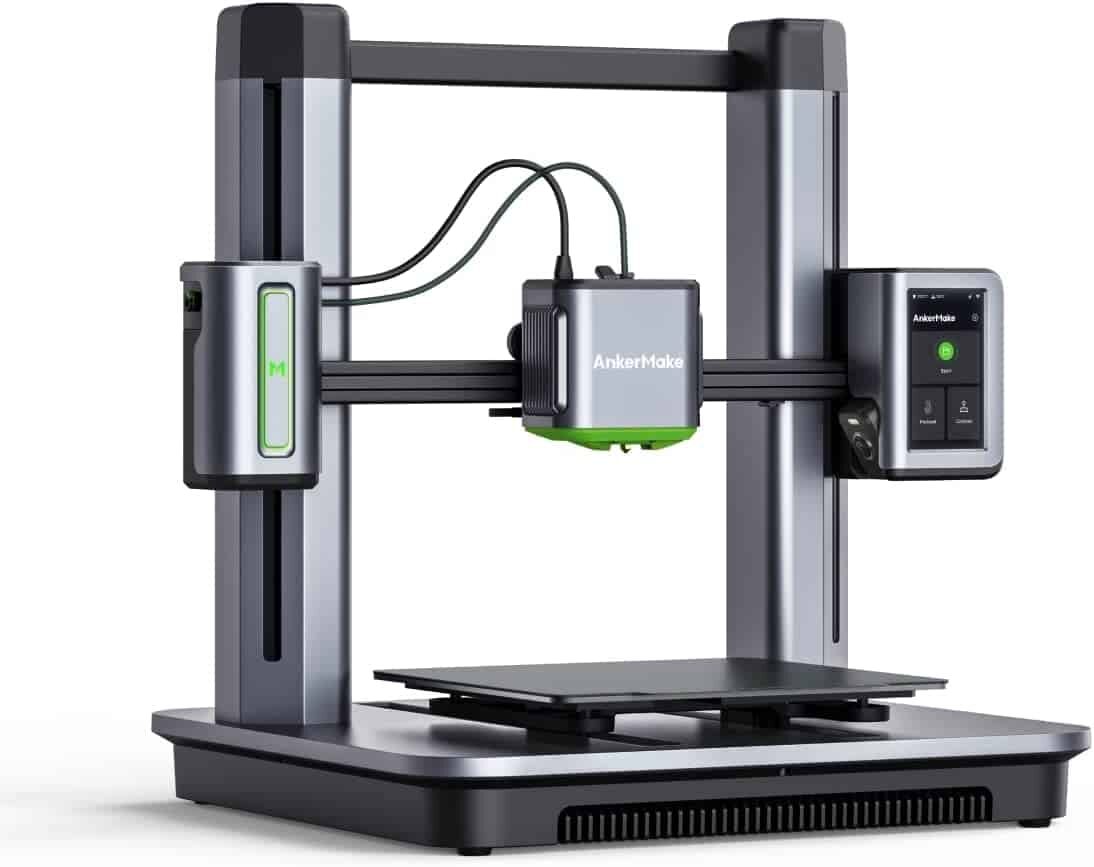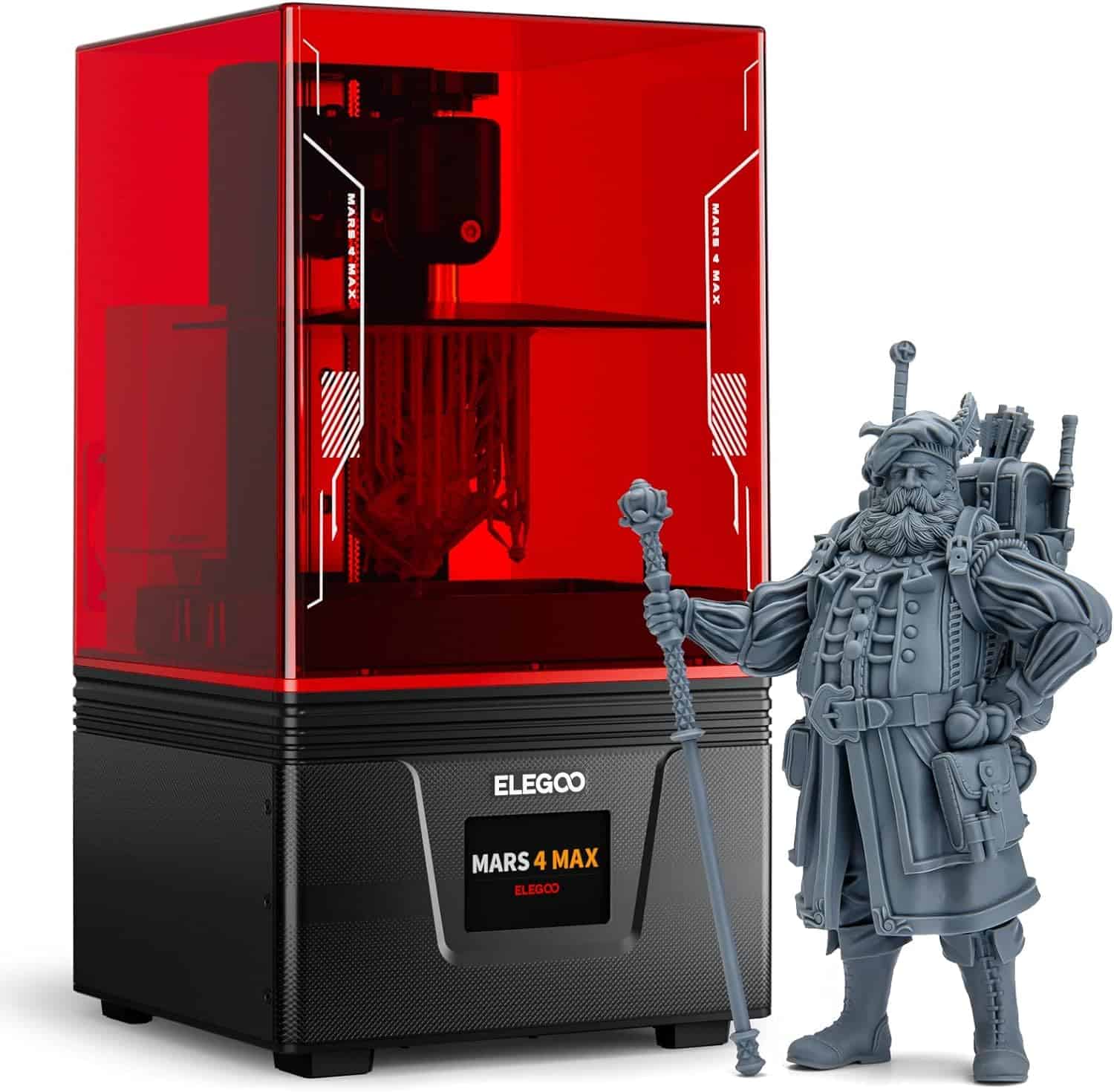Best Small 3D Printer 2024: Compact 3D Printers for Mini Prints

Table of Contents
If you want to create dazzling models but have limited space with which to do so, consider investing in one of the best small 3D printer units on the market. Offering many of the benefits of top 3D printers in a compact form, these units are tremendously valuable purchases – often saving money as well as space. They're a great entry point into the world of 3D printing, but finding the right unit can be a challenging task.
To help narrow your selection, we've compiled a guide of a number of the top 3D printers with small form factors, with recommendations across a range of different price points and specialist requirements. Whether you are looking to downsize an existing 3D printer setup or are a beginner looking to get started without having to commit to a full-scale printing setup, we have a number of terrific 3D printers to choose from.
-
Best Small 3D Printer
AnkerMake M5
- Build Volume: 235mm × 235mm × 250mm
- Filament: PLA, ABS, PETG, TPU
- Connectivity Technology: STL, OBJ
- Filetype: USB, WiFi, Bluetooth
-
Best Budget Small 3D Printer
Entina Tina 2 Mini
- Build Volume: 100mm x 120mm x 100mm
- Filament: PLA, TPU
- Connectivity Technology: USB
- Filetype: STL
-
Best Small SLA 3D Printer
ELEGOO Mars 4 Max MSLA 3D Printer
- Build Volume: 195mm x 122mm x 150mm
- Filament: SLA
- Connectivity Technology: USB
- Filetype: STL
-
Best Entry-Level Small 3D Printer
Monoprice Voxel
- Build Volume: 150mm x 150mm x 150 mm
- Filament: PLA, ABS, PETG
- Connectivity Technology: USB, WiFI
- Filetype: STL
-
Best Quiet Small 3D Printer
Flashforge Adventurer 3 Pro
- Build Volume: 220mm x 220mm x 220mm
- Filament: PLA, ABS, PETG, PC
- Connectivity Technology: USB, Ethernet, WiFi
- Filetype: STL, OBJ, AMF
How We Picked the Best Small 3D Printer
Of course, size is the primary factor when looking for the best small 3D printer: we chose printers with small footprints that make them suited to household use or small studio spaces. In conjunction with the physical volume of the 3D printer is its build volume – namely the size of prints that it can produce. We also factored in other core 3D printer features such as print speed, print resolution and filament compatibility.
We also considered a number of quality-of-life factors that, whilst not universal, make for a more refined 3D print experience. Featured such as auto-leveling print beds or vibration compensation ensure higher-quality prints, with less margin for error.
We settled on five products, each with their own respective merits, that are all sterling options for those looking for a small 3D printer. Across a range of budgets, you should be able to find a compact 3D printer no matter you financial situation – along with explanations as to why you should choose that unit over others on the market.

- Build Volume: 235mm × 235mm × 250mm
- Filament: PLA, ABS, PETG, TPU
- Connectivity Technology: STL, OBJ
- Filetype: USB, WiFi, Bluetooth
Even with a small build, the AnkerMake M5 makes impressive use of its limited scale for versatile 3D printing results.
- Fast print speeds – with a fast-mode speed of 500mm/s the M5 is incredibly productive.
- Useful camera – use the built-in camera to monitor progress, detect errors and even create stylish timelapse videos of your prints.
- Noisy – the open-frame design means the printer’s noise can be heard throughout your workspace.
Taking the top spot for our best small 3D printer is the AnkerMake M5, a top-quality option that combines all the features of professional 3D printers into a tiny design. Precise, powerful and practical; this unit is a tremendous choice for veterans and newcomers to 3D printing.
The speed of the M5 is approximately five times that of the average 3D printer, with a top speed of 500mm/s. Even with these fast print speeds, quality isn't compromised: with detail refined to within 0.1mm even at top acceleration. An open-frame printer, the M5 is capable of prints 235mm × 235mm × 250 mm in size. Along with automated leveling and filament loading, the built-in camera not only helps you track the progress of prints, but also creates stylish timelapses of the process. With compatibility for a range of filament choices such as PLA and ABS, this unit is a premium productivity powerhouse.
If we had to pick a flaw in the M5, it would be that the open-frame design leads to the print process being quite noisy, which does mean it's less suitable for homes. It's a small issue, however, and we still highly recommend the M5 as a top-quality small 3D printer.

- Build Volume: 100mm x 120mm x 100mm
- Filament: PLA, TPU
- Connectivity Technology: USB
- Filetype: STL
This ultra-compact 3D printer is both easy to buy, and even easier to store.
- Easy to use – with a user-friendly slicer and minimal setup process, the Tina 2 Mini is beginner-friendly.
- Enclosed design – with a closed frame design, fumes and noise are kept contained, making this printer easier to store and use in small spaces.
- Limited build volume – though all small 3D printers will have their limits, the Tina 2 Mini’s design limits its overall build volume.
For a compact 3D printer under $200, look no further than the Entina Tina 2 Mini, a sterling budget print solution from Entina. Budget-friendly without sacrificing quality, this is a tremendous starter option for 3D print enthusiasts.
As we mentioned in our guide on the best 3D printers for miniatures, the Tina 2 Mini is ready practically out of the box with minimal setup required. It comes with a beginner-friendly slicer so that newcomers can quickly get to grips with the ins-and-outs of 3D printing. Thanks to an enclosed 3D printer design, fumes and noise are minimized: making the printer safe for use around kids and in confined spaces.
However, the Tina 2 Mini's major limiting factor is the build volume: with only 100mm x 120mm x 100mm of space to work with, this small 3D printer limits your overall capabilities. As a starting option to experiment with 3D printing, we still highly recommend this budget 3D printer.

- Build Volume: 195mm x 122mm x 150mm
- Filament: SLA
- Connectivity Technology: USB
- Filetype: STL
Resin printing is an accessible alternative to FDM printing, and the Mars 4 Max is a compartmentalized and comprehensive means of experimenting with it.
- High-quality prints – the Mars 4 Max renders resin prints with great detail without sacrificing speed.
- Unique process – the SLA printer is a unique method of creating prints, and makes for an interesting alternative to traditional 3D printers.
- Resin only – you’re limited to a singular substrate type with resin printers, which can hamstring your creativity.
SLA printers, also known as resin 3D printers, are a popular choice among many fields that need accessible 3D print solutions. For a compact and easy-to-use resin printer, we've chosen the ELEGOO Mars 4 Max: a convenient alternative to traditional 3D printing.
Utilizing a laser against a highly light-sensitive base resin, SLA printing is a unique process to watch. With a build volume of 195mm x 122mm x 150mm, you have decent scope to watch these designs come to life. The Mars 4 Max uses a dual z-axis design for fast acceleration, meaning that prints are rendered accurately and in great time. The printer's interface is intuitive and quick to grasp, so journeymen and beginners alike shouldn't struggle to use this 3D printer.
However, you are limited to exclusively resin prints with this small 3D printer: due to their unique design, you don't have the same variety of filament choices afforded to FDM printers. If you need a compact 3D printer for easy and detailed designs, then the Mars 4 Max is still a tremendous resin-only option.

- Build Volume: 150mm x 150mm x 150 mm
- Filament: PLA, ABS, PETG
- Connectivity Technology: USB, WiFI
- Filetype: STL
The Voxel’s physical scale may not be able to change, but you’ll find it a versatile 3D printer as your own understanding of the machine improves.
- High-end customization – the Voxel allows for interchangeable print nozzles, which in turn makes for more varied print options.
- Mid-range price – boasting a great many premium features with a lower-than-average price, the Voxel is a high-value 3D print solution.
- Small filament spools – the compatible spools for the Voxel are smaller than other 3D printer spools, which leads to having to replenish them more often.
Featuring a closed-frame design and automatic leveling, the Monoprice Voxel displays a level of technical competency that some full-sized 3D printers fail to attain. With a price under $500 that retains top quality, this small 3D printer is a great mid-range option for those wanting to upgrade from a basic 3D print setup.
One of the unique features that elevates this 3D printer's versatility is the ability to swap out the print nozzles for different use cases – allowing you to get more out of this 3D printer. With a modest build size of 150mm x 150mm x 150mm, you've got room to experiment with different filament types and design ideas. These more advanced features remain optional, however, making this printer still suited to beginners. Coming with a built-in camera to remotely supervise your prints, this 3D printer is a tremendous low-footprint, high-value solution to your design needs.
One detrimental feature, however, is that whilst the build volume on the Voxel is accommodating, the spool sizes aren't – which leads to more frequent resupplying of the specific filament. It can be frustrating, but doesn't impede this unit from being a terrific compact 3D print solution.

- Build Volume: 220mm x 220mm x 220mm
- Filament: PLA, ABS, PETG, PC
- Connectivity Technology: USB, Ethernet, WiFi
- Filetype: STL, OBJ, AMF
This quiet and compact 3D printer is great for those who want minimal noise, minimal expense and minimal footprint.
- Intuitive design – quick to set up and even quicker to print, the Adventurer 3 Pro makes for a highly productive print solution.
- Large build volume – even for a small 3D printer, the accomodating print volume on this printer is an impressive addition to its value.
- Poor software – though the 3D printer itself is easy to use, the partner slicer software is far less intuitive.
Our final pick for a small 3D printer in today's ranking is the Flashforge Adventurer 3 Pro, a compact 3D printer that makes the most out of its limited dimensions. With a build volume of 220mm in all three dimensions, this print solution has the largest potential builds of any printer on this list.
Flashforge claims that you can have the Adventurer 3 Pro up-and-running within 10 minutes of unboxing, which is an impressively fast turnaround. Equally impressive is the ability for the extruders on the 3D printer to reach optimum temperatures within a handful of seconds – getting started with printing near-instantly after that. With intelligent auto-leveling and filament run-out detection, the Adventurer 3 Pro allows you to create with confidence that you don't need to carefully monitor every step of the process. And with a running noise level under 50dB, you'll almost forget it's printing.
However, the major issue with this small 3D printer is outside of the printer itself: Flashforge's slicer software is difficult to navigate, and has a steep learning curve to it. It's the one factor that prevents this 3D printer from topping our list as the best small 3D printer.
Features and Considerations
When choosing the best small 3D printer for yourself, several factors must be considered. Here are some of the most important factors based on the search results:
Build Volume
As you've seen above, each printer comes with a unique build volume. Naturally, open-frame printers come with larger volumes because they have more space for printing, while closed-frame printers have limited areas. Since each industry has its needs, you should choose a build volume depending on your work nature.
Print Speed
3D printing is a slow process at the best of times, but some units run faster than others – generally measured in millimeters per second (mm/s), with acceleration determining how quickly the 3D printer can reach those speeds when changing direction. Dual extruder 3D printers tend to be the fastest.
Filament Compatibility
There are a wide range of different filaments available for 3D printers. From standard PLA to more specialist options like Nylon. Depending on your specific build plan, be sure your 3D printer has the compatible filament listed. For instance, food-safe molds such as cookie cutters require non-toxic filaments, so be sure to double-check what you're printing with!
Connectivity Options
3D printers either come with one or multiple connectivity options. The most common option you'll come across is USB, which is convenient for laptops and PCs. However, it isn't suitable for printing from a tablet or a smartphone. If you want more freedom in choosing the device you're printing from, you should look for a 3D printer with Wi-Fi connectivity. Another useful option is SD memory compatibility, for compact transport of large files.
FAQs
Closed-frame – or enclosed – 3D printers are generally safer than open-frame models as they contain the more hazardous elements such as fumes and heat within them. However, they have more limited build volumes and can be more cumbersome to store.
Yes: if you want to experiment with 3D printing without committing to the cost of a full-fledged 3D printer, then a smaller 3D printer is a great investment. The best small 3D printer models retain all the benefits of their larger contemporaries, on a smaller scale.
Verdict

- Build Volume: 235mm × 235mm × 250mm
- Filament: PLA, ABS, PETG, TPU
- Connectivity Technology: STL, OBJ
- Filetype: USB, WiFi, Bluetooth
Though it's not as quiet as we'd like, the AmkerMake M5 is the best small 3D printer on the market. Combining an accommodating build volume with top-shelf features and print quality, all at a reasonable price; this unit offers tremendous value to 3D print enthusiasts both old and new.
Looking for more varied prints? Check out our guide on the best multi-color 3D printers on the market today.